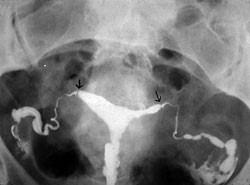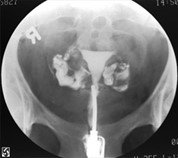
Before explaining what the HSG is for, let’s remember our information about fertilization and the placement of the fertilized egg cell in the uterus.
One of the most important causes of infertility in women is adhesions in the tubes.
Fertilization, that is, the union of sperm and egg cell, takes place in the tubes. For this to happen, the tube channels must be smooth and open.
Adhesions formed in the tubes disrupt the smooth, tubular structure of the tube and make it twisted, curved, swollen, and that tube can no longer work.
Untreated discharges-infections, endometriosis disease, ovarian cysts, sometimes fibroids, previous surgeries on the uterus and ovaries may be the cause of adhesions in the tubes. Tubes become convoluted and curved. As a result of all these disorders, it is not possible for the sperm and egg cell to unite in this conjoined, adherent tube, and fertilization may not occur.
In about half of infertile women, the problem is that the tubes are damaged so that they cannot function normally.
On the other hand, the endometrial line must be smooth in order for the fertilized egg cell, that is, the embryo, to settle in the inner lining of the uterus. In the presence of diseases such as polyps in the uterine lining or myomas that disrupt some uterine lining, the embryo cannot adhere to the irregular uterine lining and pregnancy cannot continue, even if fertilization occurs in the tube.
Here, we call HSG or uterine film to the examination we do to understand whether the tube channels are smooth and open, and whether the inner lining of the uterus is regular.
Who are candidates for HSG?
We definitely want to perform HSG before treatment in patients over 35 years of age who want a child, have a history of inflammation involving the uterus and ovaries in the past, have a history of ectopic pregnancy, and have findings suggestive of pelvic pathology (nodularity, fixation, severe pain) on examination.
How is the procedure?
We do the HSG right after the menstrual bleeding ends. Before the procedure, we examine the vagina and cervix and treat any discharge, if any.
Since the HSG procedure is somewhat painful, we perform the procedure under anesthesia in our clinic. In this way, we control the patency of the tubes without our patient feeling any discomfort.
The patient lies on the table like having a gynecological examination. After placing the inspection tool in the vagina, we insert a special tube into the cervix. Through this tube, we inject the necessary medicine for the HSG into the uterus and the tubes.
Thus, it can be seen whether the inner membrane of the uterus is smooth and whether both tubes are open.
If we have noticed the tubes are not open with the HSG, the possible cause of infertility will be determined. Since the tubes are clogged, the egg cell and sperm cannot unite, so fertilization does not occur. However, rarely, clogged tubes can be seen in the uterine film by mistake. To rule out this possibility, if the tubes seem blocked, we can confirm with laparoscopy surgery. If the tubes are clogged in laparoscopy, then in vitro fertilization procedures should be started. If the uterine film is normal, instead of going to IVF, we apply timed intercourse or IUI treatment.

You can contact us by calling 0545 405 01 37 and 0318 233 03 03 to make an appointment for a HSG from our clinic.
Click for detailed information about IVF Treatment
Prof. Dr. Yavuz ŞİMŞEK
